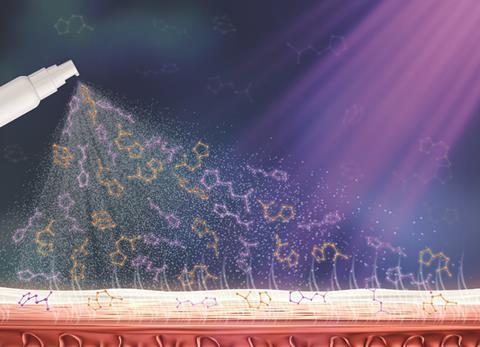Researchers in Amsterdam have laid the first foundations for a sunscreen based on a molecule found naturally in the skin: urocanic acid. They have published extensive spectroscopic data in two papers in Physical Chemistry Chemical Physics.
‘Many ingredients in sunscreens are under fire because they can have negative side effects on health and the environment, such as damage to coral reefs’, says Wybren Jan Buma, professor of molecular photonics at the University of Amsterdam. ‘This is one of the reasons why my group is researching new molecules for sunscreens that convert harmful UV radiation into harmless heat.’
Serotonin
Buma and his colleagues are mainly looking at derivatives of systems that already exist in nature, such as cinemates, of which cinnamic acid is a well-known example. ‘One variant of such a cinemate is urocanic acid, which has an imidazole ring in its structure, and this gives photophysical and photochemical access to all sorts of interesting and novel properties’, Buma explains.
Urocanic acid occurs naturally in the skin, where it acts as a UV-B filter. It was therefore added to sunscreens, but in the 1980s the cis-isomer, which is converted from trans-urocanic acid by sunlight, was found to be harmful. Cis-urocanic acid is very similar to serotonin, so it also coordinates to the serotonin receptor’, Buma continues. ‘This leads to an immunosuppressive response, so it has been removed from the products.’
Article continues below

Tautomerisation
The ultimate goal of the Amsterdam researchers is to use molecules to efficiently convert light into heat. Buma: “The transition to the electronically excited state should be very easy, but at the same time the fall back should not occur through channels that could be dangerous, such as triplets that cause side reactions.’ The question they wanted to answer was: how effectively can urocanic acid convert light into heat, and if you make non-toxic derivatives of it that don’t fit the serotonin receptor, what is the effect on the photophysical and photochemical properties?
‘The imidazole ring of urocanic acid has two N atoms and can occur in two tautomers, N1H- and N3H-urocanic acid’, says Buma. ‘You can put a methyl group at either position, and we discovered that substitution at N1 is much better in terms of properties than N3, which was not known before. It also avoids tautomerisation. This is something that leaves room for further optimisation.’
There is also a lot to be gained at a fundamental level, Buma explains enthusiastically. ‘For a spectroscopist, this is heaven on earth: there are two electronically excited states very close together. From a pure, fundamental point of view, there are so many nice things to study: the mixing of states, the transformation of these states, the dependence on the vibrational state of the molecule, and so on. Unfortunately, for the current funding instruments, this is really very fundamental science, and a direct link to a socially relevant application is needed to increase the chances of funding this kind of research.’
Reference point
What does the future hold for urocanic acid derivatives? ‘First, we need to see if we can make a priori statements about which substitutions are good for reducing toxicity and if these compounds are easy to synthesise’, says Buma. ‘And, of course, they have to retain their photophysical properties. You can compare it with drug development. You start with a lead, and you have to develop it. It is the same with urocanic acid. Since many synthetic ingredients in sunscreens have come under fire, we hope that the cosmetics industry will take up our work, in which we use a bottom-up approach rather than the empirical top-down approach that is often standard there.’
Sunscreen for plants
The molecules studied by Buma and his colleagues also have other applications in agriculture and horticulture, for example. Buma: ‘This is a molecular spray that you spray on plants. Last September, we conducted field trials in Spain and Germany where we sprayed different crops with one of these molecular heaters, as we call them. The molecule converts sunlight into heat, so you can protect crops from the cold or even make them grow earlier. In the trials, we saw that the crop yields were higher and better than some of the other existing seaweed-based products. This was incredibly exciting to see, but even in this field, it takes a long time for a molecule like this to actually reach the market.’



















Nog geen opmerkingen